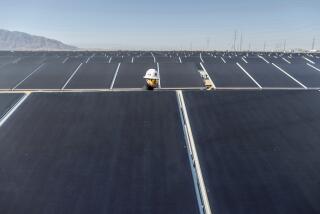How green is Measure B?
There’s good news and bad news for solar energy supporters in Southern California. The good news is that the amount of solar infrastructure installed in our state doubled from 2007 to 2008. The bad news is that the Los Angeles Department of Water and Power is the dirtiest utility in California. About 50% of the electricity it sells to its customers comes from coal, a resource the rest of California has shunned because of its planet-killing attributes. This has to change.
So when the DWP last fall announced an ambitious solar energy program, it was like a ray of sunshine bursting through the smog. My group -- the Vote Solar Initiative -- is supportive, but only if the utility agrees to open markets for competition and stops trying to hijack money meant to help ratepayers go solar on their own. It’s your money, not theirs.
The DWP’s overall solar plan comes in two parts. The first element of the program, Measure B, is on the March 3 ballot. Measure B would authorize the utility to build 400 megawatts’ worth of solar photovoltaics on land and rooftops inside the city. That is enough energy to power 240,000 homes, and the solar panels would cover about 900 acres of warehouse rooftops, parking lots and unused rights of way.
Is utility-owned solar generation a good idea? Utilities are large players in the electricity world, and having them involved can potentially bring enormous economies of scale to the solar industry. Organized labor’s support for Measure B brings a powerful political constituency to help make solar happen in DWP territory, where it has long been delayed. But many worry that utilities can assert monopolistic control over wires and leverage their enormous market power to crowd out smaller solar installers and ultimately stifle the industry. In the case of Measure B, some believe that private solar companies, with deep expertise honed in a competitive environment, can provide the same solar service more cheaply than the DWP.
As it happens, several other utilities across the country have already announced programs similar to Measure B. My organization has intervened in several of the proceedings with a clear remedy: Allow utility-owned solar generation, but only on the conditions that markets are kept open for competition from private developers and customers are free to go solar on their own. The best way to mitigate the potential downsides of utilities getting into the solar business is to ensure that markets stay open for all business models.
How does the DWP fare under this metric? The second part of its overall solar plan is a mixed bag. It features 500 megawatts of central-station solar power to be developed in the desert under a competitive solicitation, 150 megawatts from a feed-in tariff (a system of procuring wholesale electricity under standard-offer, fixed-price contracts) and 100 megawatts of cooperatively owned solar power called SunShares. This is all good.
However, there are real reasons to worry when it comes to the DWP’s approach to customers who try to go solar on their own to reduce their utility bills. The DWP does not allow its customers to purchase solar electricity from third-party solar developers, a very popular model in the rest of the state that allows schools and businesses to harness tax credits and hedge against future utility rate increases.
Even worse, during the last legislative session, the DWP supported a bill that would have allowed the utility to raid the state’s SB 1 fund -- which was developed under the California Solar Initiative, a program that provides rebates for customers who install solar systems on their roofs and reduce their electricity bills -- and use the money for utility-owned wholesale power generation. It was an appalling move, and when my organization asked the governor to veto the bill, he did. Though the DWP has committed to generating 280 megawatts of solar energy via customer incentives under SB 1, the utility’s plan lists only 130 megawatts that would come from qualifying customer programs. Department officials say they will follow the letter of the law, but it’s pretty clear that they mean to follow the letter of the law until they can get the law changed. That’s unacceptable, and the mayor and the leadership of the DWP should disavow these market-restricting tactics.
There are a couple of additional things to keep in mind when evaluating Measure B.
First, solar is about to become significantly cheaper. For the last five years, global demand for photovoltaics, fueled by generous fixed-price supports in Europe, exceeded global manufacturing capacity. This year, the industry finally reached the inversion point, and capacity now exceeds demand. The photovoltaic industry now has a global manufacturing base. Some of the world’s largest manufacturers have already announced price reductions of up to 30%. We have entered a world of new possibilities in solar energy.
Second, the time to start dramatically increasing our use of renewable energy was yesterday. NASA climatologist James Hansen tells us that if we want to keep the world we evolved in, we must reduce carbon dioxide levels in the atmosphere to 350 parts per million. Doing so would require dedicating a land area roughly equal to the size of Australia to renewable energy generation, according to Saul Griffith, a MacArthur “genius” grant recipient. And we need to do it in the next 25 years.
What’s more important than the 400 megawatts of solar energy envisioned in Measure B is an enduring, sustainable market capable of delivering much more. Angelenos should demand that the mayor and the DWP commit to keeping all ways of going solar open. If they do make this commitment, you should vote for Measure B. After all, we fight global warming with the DWP we have, not the DWP we wish to have. And time is running out.
Adam Browning is co-founder and executive director of the Vote Solar Initiative, a nonprofit organization working to bring solar energy into the mainstream.






